*NURSING > QUESTIONS & ANSWERS > SOLVED!!! NR 509 COMPREHENSIVE REVIEW OF JARVIS 7TH EDITION CHAPTER 14 QUESTIONS (Eyes: Physical Exa (All)
SOLVED!!! NR 509 COMPREHENSIVE REVIEW OF JARVIS 7TH EDITION CHAPTER 14 QUESTIONS (Eyes: Physical Examination & Health Assessment)
Document Content and Description Below
SOLVED!!! NR 509 COMPREHENSIVE REVIEW OF JARVIS 7TH EDITION CHAPTER 14 QUESTIONS (Eyes: Physical Examination & Health Assessment) ◇This material contains comprehensive summary of information in the... form of great test questions with descriptive answers helpful for exams study. Thorough Review of Jarvis 7th Edition Chapter 14 Questions. All the best Champions! ______ MULTIPLE CHOICE 1. When examining the eye, the nurse notices that the patient’s eyelid margins approximate completely. The nurse recognizes that this assessment finding: Is expected. a. b. May indicate a problem with extraocular muscles. c. May result in problems with tearing. d. Indicates increased intraocular pressure. ANS: A The palpebral fissure is the elliptical open space between the eyelids, and, when closed, the lid margins approximate completely, which is a normal finding. DIF: Cognitive Level: Understanding (Comprehension) REF: p. 281 MSC: Client Needs: Physiologic Integrity: Physiologic Adaptation 2. During ocular examinations, the nurse keeps in mind that movement of the extraocular muscles is: a. Decreased in the older adult. b. Impaired in a patient with cataracts. c. Stimulated by cranial nerves (CNs) I and II. d. Stimulated by CNs III, IV, and VI. ANS: D Movement of the extraocular muscles is stimulated by three CNs: III, IV, and VI. DIF: Cognitive Level: Remembering (Knowledge) REF: p. 283 MSC: Client Needs: Physiologic Integrity: Physiologic Adaptation 3. The nurse is performing an external eye examination. Which statement regarding the outer layer of the eye is true? a. The outer layer of the eye is very sensitive to touch. b. The outer layer of the eye is darkly pigmented to prevent light from reflecting internally. c. d. The trigeminal nerve (CN V) and the trochlear nerve (CN IV) are stimulated when the outer surface of the eye is stimulated. The visual receptive layer of the eye in which light waves are changed into nerve impulses is located in the outer layer of the eye. ANS: AThe cornea and the sclera make up the outer layer of the eye. The cornea is very sensitive to touch. The middle layer, the choroid, has dark pigmentation to prevent light from reflecting internally. The trigeminal nerve (CN V) and the facial nerve (CN VII) are stimulated when the outer surface of the eye is stimulated. The retina, in the inner layer of the eye, is where light waves are changed into nerve impulses. DIF: Cognitive Level: Understanding (Comprehension) REF: p. 283 MSC: Client Needs: Physiologic Integrity: Physiologic Adaptation 4. When examining a patient’s eyes, the nurse recalls that stimulation of the sympathetic branch of the autonomic nervous system: Causes pupillary constriction. a. b. Adjusts the eye for near vision. c. Elevates the eyelid and dilates the pupil. d. Causes contraction of the ciliary body. ANS: C Stimulation of the sympathetic branch of the autonomic nervous system dilates the pupil and elevates the eyelid. Parasympathetic nervous system stimulation causes the pupil to constrict. The muscle fibers of the iris contract the pupil in bright light to accommodate for near vision. The ciliary body controls the thickness of the lens. DIF: Cognitive Level: Understanding (Comprehension) REF: p. 283 MSC: Client Needs: Physiologic Integrity: Physiologic Adaptation 5. The nurse is reviewing causes of increased intraocular pressure. Which of these factors determines intraocular pressure? a. Thickness or bulging of the lens b. Posterior chamber as it accommodates increased fluid c. d. Contraction of the ciliary body in response to the aqueous within the eye Amount of aqueous produced and resistance to its outflow at the angle of the anterior chamber ANS: D Intraocular pressure is determined by a balance between the amount of aqueous produced and the resistance to its outflow at the angle of the anterior chamber. The other responses are incorrect. DIF: Cognitive Level: Remembering (Knowledge) REF: p. 284 MSC: Client Needs: Physiologic Integrity: Physiologic Adaptation 6. The nurse is conducting a visual examination. Which of these statements regarding visual pathways and visual fields is true? a. The right side of the brain interprets the vision for the right eye. b. The image formed on the retina is upside down and reversed from its actual appearance in the outside world.c. d. Light rays are refracted through the transparent media of the eye before striking the pupil. Light impulses are conducted through the optic nerve to the temporal lobes of the brain. ANS: B The image formed on the retina is upside down and reversed from its actual appearance in the outside world. The light rays are refracted through the transparent media of the eye before striking the retina, and the nerve impulses are conducted through the optic nerve tract to the visual cortex of the occipital lobe of the brain. The left side of the brain interprets vision for the right eye. DIF: Cognitive Level: Remembering (Knowledge) REF: p. 284 MSC: Client Needs: Physiologic Integrity: Physiologic Adaptation 7. The nurse is testing a patient’s visual accommodation, which refers to which action? a. Pupillary constriction when looking at a near object b. Pupillary dilation when looking at a far object Changes in peripheral vision in response to light c. d. Involuntary blinking in the presence of bright light ANS: A The muscle fibers of the iris contract the pupil in bright light and accommodate for near vision, which also results in pupil constriction. The other responses are not correct. DIF: Cognitive Level: Remembering (Knowledge) REF: p. 296 MSC: Client Needs: Physiologic Integrity: Physiologic Adaptation 8. A patient has a normal pupillary light reflex. The nurse recognizes that this reflex indicates that: a. The eyes converge to focus on the light. b. Light is reflected at the same spot in both eyes. c. The eye focuses the image in the center of the pupil. d. Constriction of both pupils occurs in response to bright light. ANS: D The pupillary light reflex is the normal constriction of the pupils when bright light shines on the retina. The other responses are not correct. DIF: Cognitive Level: Understanding (Comprehension) REF: p. 296 MSC: Client Needs: Physiologic Integrity: Physiologic Adaptation 9. A mother asks when her newborn infant’s eyesight will be developed. The nurse should reply: a. “Vision is not totally developed until 2 years of age.” b. c. “Infants develop the ability to focus on an object at approximately 8 months of age.” “By approximately 3 months of age, infants develop more coordinated eyemovements and can fixate on an object.” d. “Most infants have uncoordinated eye movements for the first year of life.” ANS: C Eye movements may be poorly coordinated at birth, but by 3 to 4 months of age, the infant should establish binocularity and should be able to fixate simultaneously on a single image with both eyes. DIF: Cognitive Level: Applying (Application) MSC: Client Needs: Health Promotion and Maintenance 10. The nurse is reviewing in age-related changes in the eye for a class. Which of these physiologic changes is responsible for presbyopia? a. Degeneration of the cornea b. Loss of lens elasticity c. Decreased adaptation to darkness d. Decreased distance vision abilities ANS: B The lens loses elasticity and decreases its ability to change shape to accommodate for near vision. This condition is called presbyopia. DIF: Cognitive Level: Understanding (Comprehension) MSC: Client Needs: Health Promotion and Maintenance REF: p. 286 11. Which of these assessment findings would the nurse expect to see when examining the eyes of a black patient? a. Increased night vision b. Dark retinal background Increased photosensitivity c. d. Narrowed palpebral fissures ANS: B An ethnically based variability in the color of the iris and in retinal pigmentation exists, with darker irides having darker retinas behind them. DIF: Cognitive Level: Understanding (Comprehension) REF: p. 286 MSC: Client Needs: Safe and Effective Care Environment: Management of Care 12. A 52-year-old patient describes the presence of occasional floaters or spots moving in front of his eyes. The nurse should: a. Examine the retina to determine the number of floaters. b. Presume the patient has glaucoma and refer him for further testing. Consider these to be abnormal findings, and refer him to an ophthalmologist. c. d. Know that floaters are usually insignificant and are caused by condensed vitreous fibers. ANS: D REF: p. 302Floaters are a common sensation with myopia or after middle age and are attributable to condensed vitreous fibers. Floaters or spots are not usually significant, but the acute onset of floaters may occur with retinal detachment. DIF: Cognitive Level: Analyzing (Analysis) MSC: Client Needs: Health Promotion and Maintenance 13. The nurse is preparing to assess the visual acuity of a 16-year-old patient. How should the nurse proceed? a. Perform the confrontation test. b. Ask the patient to read the print on a handheld Jaeger card. c. Use the Snellen chart positioned 20 feet away from the patient. d. Determine the patient’s ability to read newsprint at a distance of 12 to 14 inches. ANS: C The Snellen alphabet chart is the most commonly used and most accurate measure of visual acuity. The confrontation test is a gross measure of peripheral vision. The Jaeger card or newspaper tests are used to test near vision. DIF: Cognitive Level: Analyzing (Analysis) REF: p. 289 MSC: Client Needs: Safe and Effective Care Environment: Management of Care 14. A patient’s vision is recorded as 20/30 when the Snellen eye chart is used. The nurse interprets these results to indicate that: a. At 30 feet the patient can read the entire chart. b. The patient can read at 20 feet what a person with normal vision can read at 30 feet. c. d. The patient can read the chart from 20 feet in the left eye and 30 feet in the right eye. The patient can read from 30 feet what a person with normal vision can read from 20 feet. ANS: B The top number indicates the distance the person is standing from the chart; the denominator gives the distance at which a normal eye can see. DIF: Cognitive Level: Applying (Application) REF: p. 290 MSC: Client Needs: Physiologic Integrity: Physiologic Adaptation 15. A patient is unable to read even the largest letters on the Snellen chart. The nurse should take which action next? a. b. c. Refer the patient to an ophthalmologist or optometrist for further evaluation. Assess whether the patient can count the nurse’s fingers when they are placed in front of his or her eyes. Ask the patient to put on his or her reading glasses and attempt to read the Snellen chart again. d. Shorten the distance between the patient and the chart until the letters are seen, and REF: p. 287record that distance. ANS: D If the person is unable to see even the largest letters when standing 20 feet from the chart, then the nurse should shorten the distance to the chart until the letters are seen, and record that distance (e.g., “10/200”). If visual acuity is even lower, then the nurse should assess whether the person can count fingers when they are spread in front of the eyes or can distinguish light perception from a penlight. If vision is poorer than 20/30, then a referral to an ophthalmologist or optometrist is necessary, but the nurse must first assess the visual acuity. DIF: Cognitive Level: Analyzing (Analysis) REF: p. 290 MSC: Client Needs: Physiologic Integrity: Physiologic Adaptation 16. A patient’s vision is recorded as 20/80 in each eye. The nurse interprets this finding to mean that the patient: a. Has poor vision. b. Has acute vision. c. Has normal vision. d. Is presbyopic. ANS: A Normal visual acuity is 20/20 in each eye; the larger the denominator, the poorer the vision. DIF: Cognitive Level: Applying (Application) REF: p. 290 MSC: Client Needs: Physiologic Integrity: Physiologic Adaptation 17. When performing the corneal light reflex assessment, the nurse notes that the light is reflected at 2 o’clock in each eye. The nurse should: Consider this a normal finding. a. b. Refer the individual for further evaluation. c. Document this finding as an asymmetric light reflex. d. Perform the confrontation test to validate the findings. ANS: A Reflection of the light on the corneas should be in exactly the same spot on each eye, or symmetric. If asymmetry is noted, then the nurse should administer the cover test. DIF: Cognitive Level: Analyzing (Analysis) REF: p. 292 MSC: Client Needs: Safe and Effective Care Environment: Management of Care 18. The nurse is performing the diagnostic positions test. Normal findings would be which of these results? a. Convergence of the eyes b. Parallel movement of both eyes c. Nystagmus in extreme superior gaze d. Slight amount of lid lag when moving the eyes from a superior to an inferior position [Show More]
Last updated: 1 year ago
Preview 1 out of 14 pages
.png)
Buy this document to get the full access instantly
Instant Download Access after purchase
Add to cartInstant download
We Accept:

Reviews( 0 )
$15.00
Document information
Connected school, study & course
About the document
Uploaded On
Sep 12, 2021
Number of pages
14
Written in
Additional information
This document has been written for:
Uploaded
Sep 12, 2021
Downloads
0
Views
48

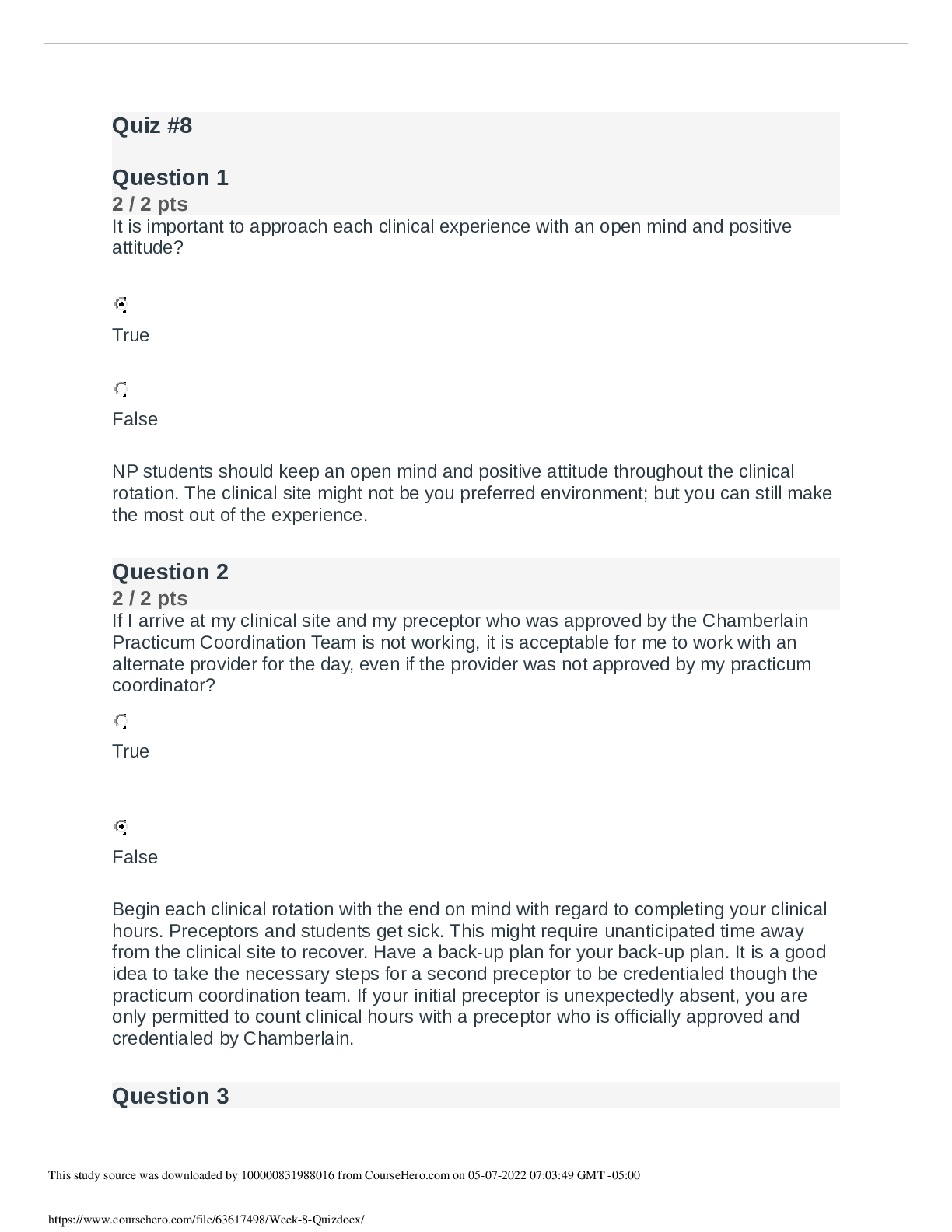



.png)
.png)
.png)
.png)

.png)

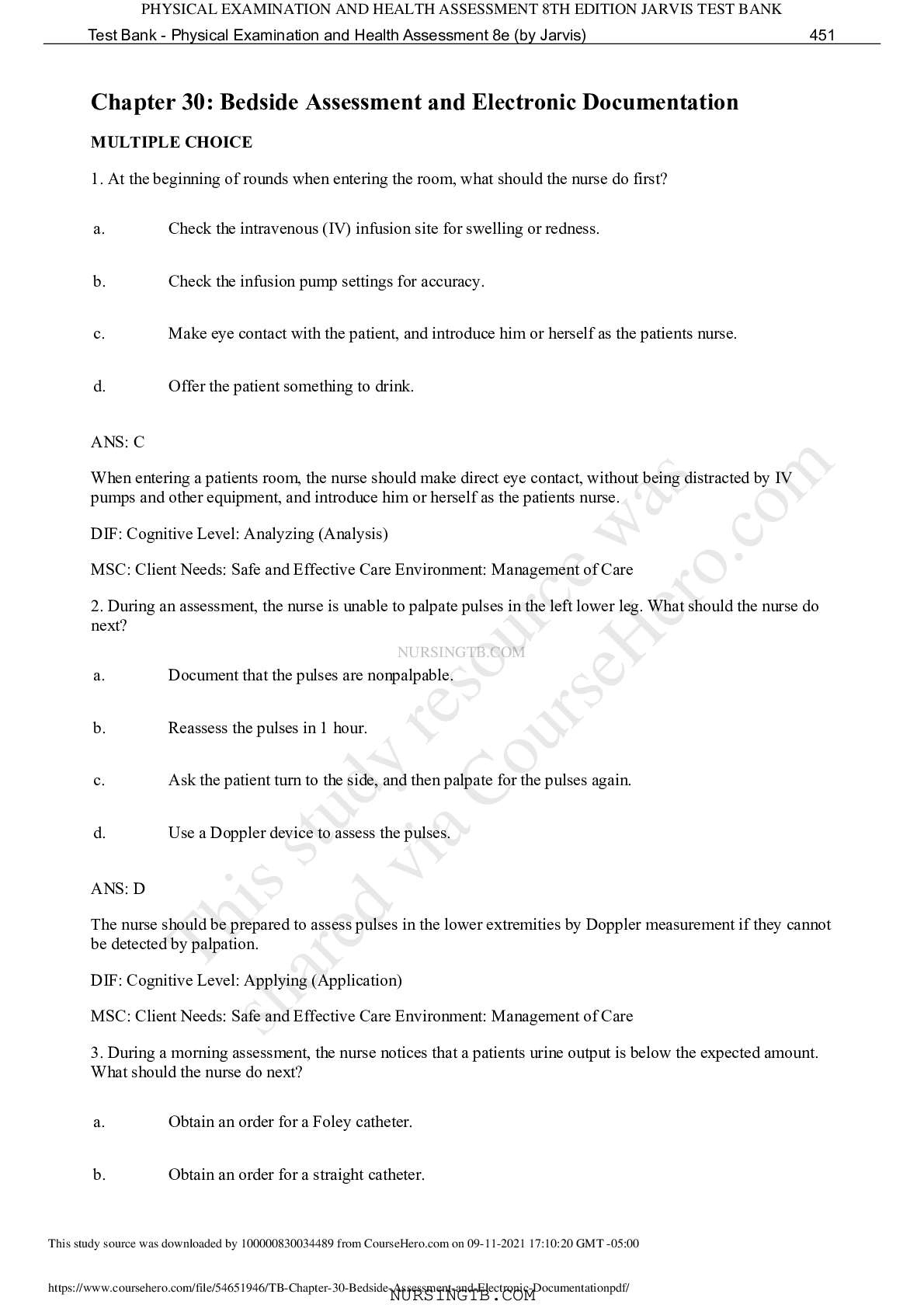
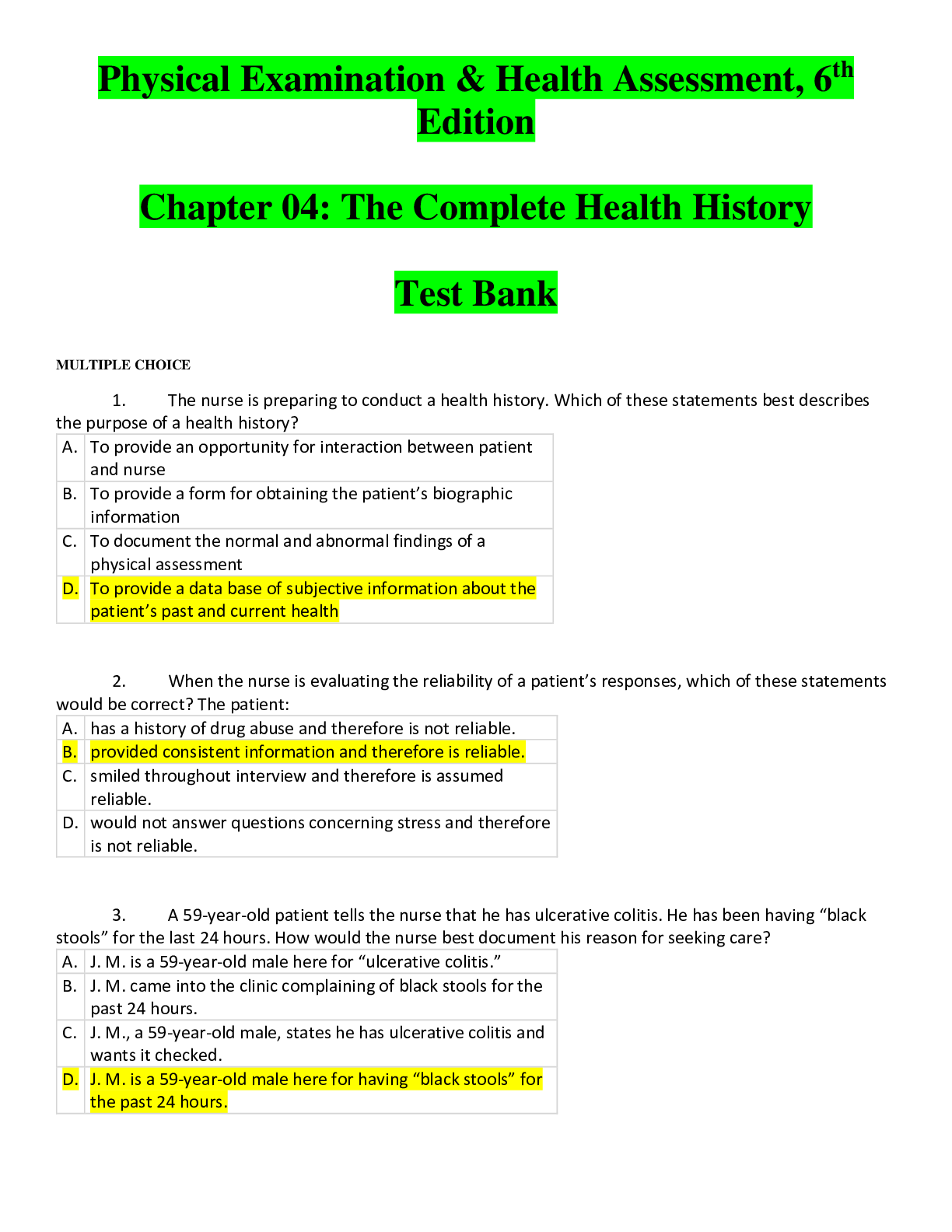
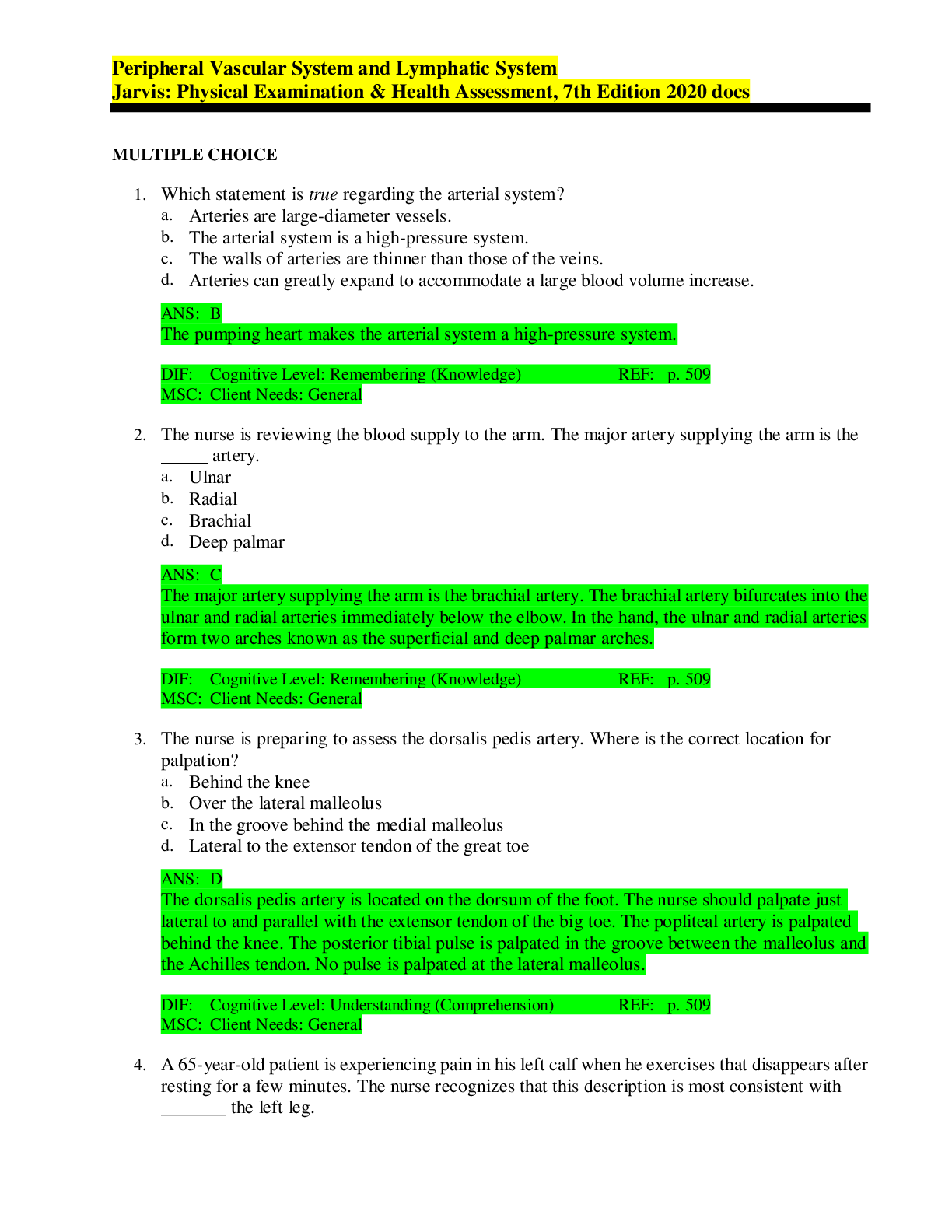
 answers.png)
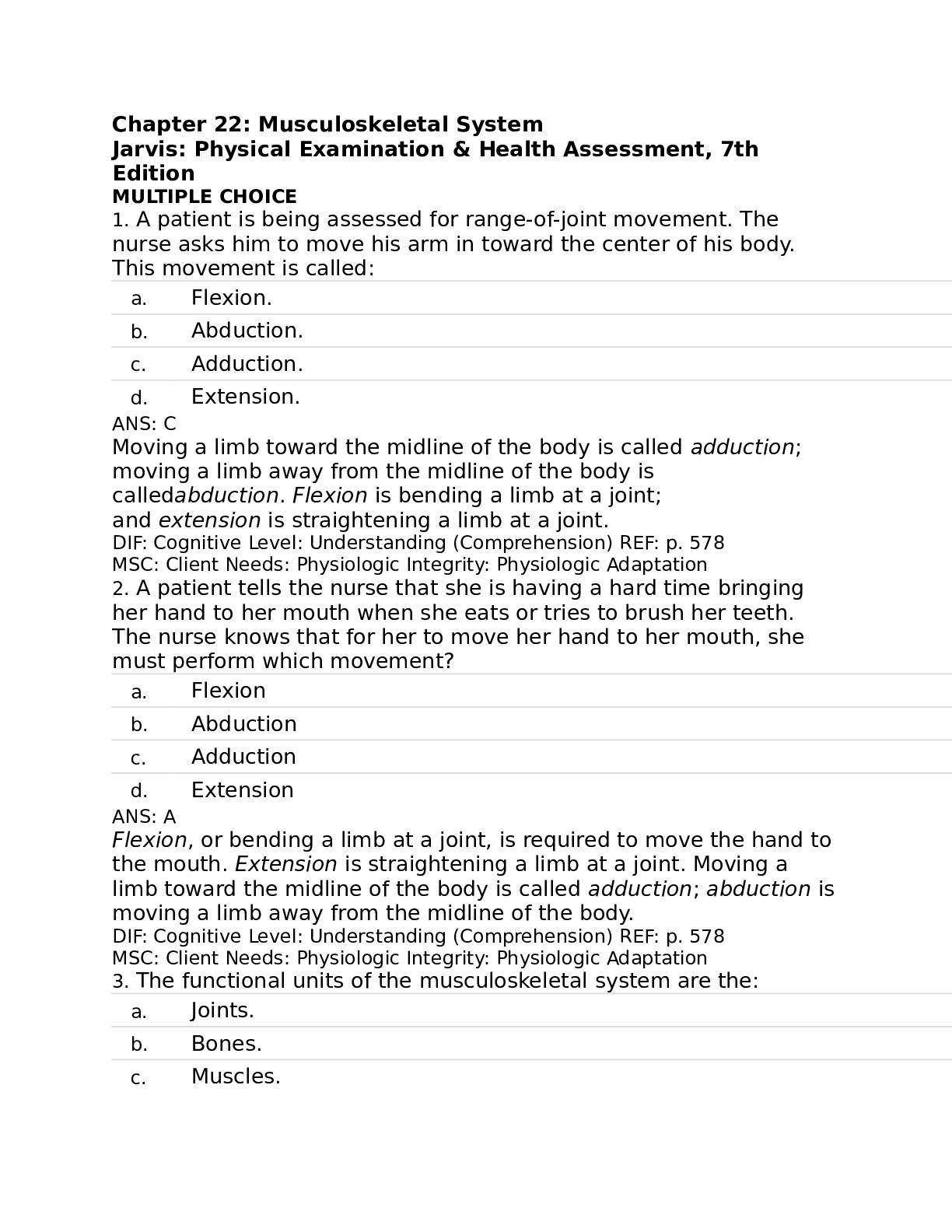
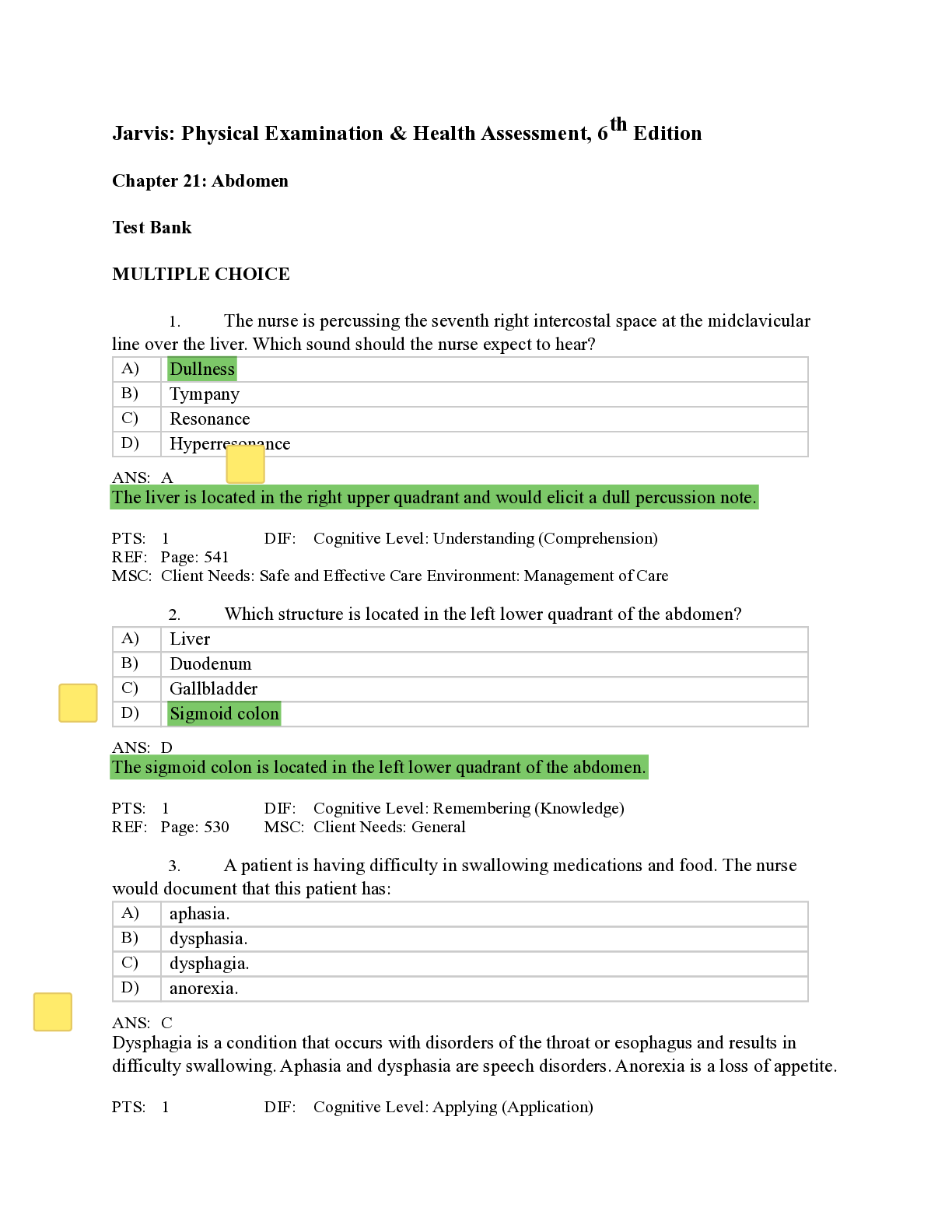
, Latest Questions and Answers with Explanations for Revision, All C.png)
, Latest Questions and Answers with Explanations for Revision, All Correct Latest Review, (La.png)
, Latest Questions and Answers with Explanations for Revision, All Correct Latest Review, (Latest 2021) Correc.png)
, Latest Questions and Answers with Explanations for Revision, All Correct Latest Revie.png)


